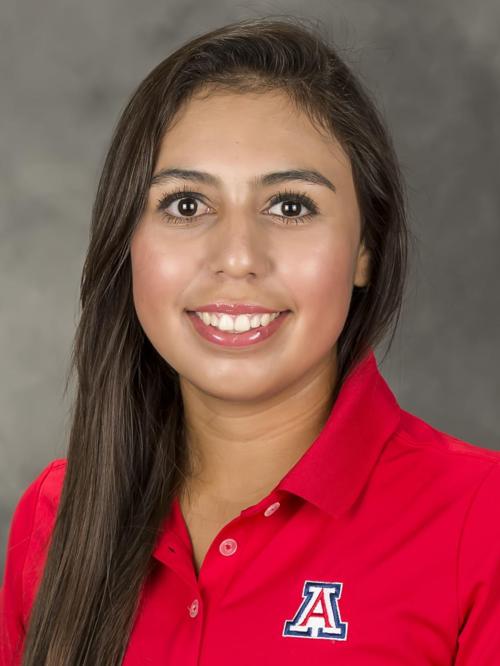The UA’s most significant personnel loss in the last five sports years, leaving school with eligibility remaining, was neither Scooby Wright, Bobby Dalbec nor Lauri Markkanen.
It was Krystal Quihuis.
She is maybe 5 feet 2 inches tall, can’t sack a quarterback, hit a 3-run home run or bury a 3-pointer. But, oh, how the 15th-ranked Arizona women’s golf team could use her.
Two weeks ago, Quihuis made her pro debut on the LPGA’s Symetra Tour, shooting rounds of 73-73-70 in Winter Haven, Florida, to finish 14th of 134 players. She didn’t get rich, but Quihuis was paid $2,000, and for those who understand how difficult it is to go from college golf to the Symetra Tour, it was a “WOW” moment — capital letters.
“I’ve got to admit, it was awesome getting paid,” she said with a laugh.
Quihuis entered the 2017-18 Arizona season as the No. 2 golfer on a loaded team that seemed destined to challenge for its first national championship in 18 years. All of the pieces fit: Quihuis joined All-Pac-12 junior Haley Moore, valued freshman Yu-Sang Hou, Gonzaga transfer Bianca Pagdanganan and Oregon Women’s Amateur champion Gigi Stoll.
That stacked up as a fivesome comparable to any in school history, including those from the Annika Sorenstam, Marisa Baena and Lorena Ochoa days.
But after playing in 36 events for the Wildcats, including three in fall semester — after forging a reputation as one of the steadiest players in NCAA golf — Quihuis paid $1,500 to enter the LPGA Qualifying School in Daytona Beach, Florida.
To the surprise of few, the two-time state champion from Salpointe Catholic qualified for the 2018 Symetra Tour, which is the LPGA’s version of the NBA G League.
What came next might’ve been more difficult than playing Augusta National’s Amen Corner in a hailstorm. Quihuis had to choose between playing her final semester at Arizona or going immediately to the pro tour.
The variables were clear: Quihuis would be able to play in at least six of the year’s 21 Symetra Tour events while Arizona was completing the NCAA season. The top 10 money winners on the Symetra Tour will earn 2019 LGPA Tour cards.
Delaying entry to the Symetra Tour would likely set back Quihuis’ pro ambitions by at least a year. It wasn’t a now-or-never choice, but given the game’s fickle nature, you never know when a chance to play on a pro golf tour will come again.
“It was such a tough decision,” she says. “I sat down with my family and discussed the pros and cons. We listed them on a sheet of paper. What would be the most beneficial choice? It was just tough.”
Fifteen years ago, UA All-American Erica Blasberg who, like Quihuis, had been the Pac-12 Freshman of the Year, wrestled with a similar choice. Her father, Mel, told me it wasn’t a decision based on money, but rather opportunity.
“Erica needs to improve by one stroke a round to compete on the LPGA Tour,” Mel Blasberg told me then. “We’ve decided she can better do that by playing and practicing full time rather than return to school.”
One stroke. It’s that close for any golfer of Quihuis’ stature.
Quihuis averaged 72.16 at Arizona a year ago. How good is that? Lorena Ochoa, the 2002 NCAA Player of the Year, averaged 70.13 as an Arizona sophomore and turned pro. If Quihuis can shave a stroke per round off her average Arizona score, it’s likely she’ll finish in the top 10 on the Symetra Tour money list and get full privileges on the LPGA Tour in 2019.
She averaged a 72 on her Symetra debut. It is a promising start.
“To be honest, playing on the Symetra Tour felt like any other tournament to me,” Quihuis says. “Par is still the same.”
Some things haven’t changed for Quihuis; her father, Albert, who works for the City of Tucson, is her caddy. Albert, an accomplished amateur golfer in the 1980s and ’90s, has been his daughter’s caddy and swing coach since she was 7.
She also continues to work with Phoenix-based instructor Kene Bensel, and has made time to complete her UA degree requirements online. Quihuis was on the Dean’s List in 2017 and will graduate in May. That’s about the time the Symetra Tour goes on a swing through South Carolina and North Carolina.
Since her days at Salpointe, Quihuis has been defined by her diligence and work ethic She grew up playing on Tucson’s muni courses, often with her father at her side. She spent as much time on the El Rio Golf Course and at the Randolph Golf Complex as many of her contemporaries spent at high-end country club practice facilities.
In the end, it doesn’t matter where you practice.
Quihuis’ journey to the pro tour began in Tucson’s Ricki Rarick summer program for kids. She laughs at the memory of being placed in the boys division.
“It was a source of motivation,” she remembers. “I’d ask how come there were no trophies for the girls. I was told that if I wanted to win, I’d have to compete with the boys. I’d have to put in the work and practice harder than the others. That pushed me to be the player I am.”





